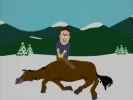I first heard about the
Camino de Santiago ten years before I was able to walk it. The first person I contacted for information was the priest of the local „Jakobskirche“ (Santiago church). He said:
If you want to experience something that will mark you in a good way for the rest of your life, walk to Santiago from your home in one go. In other words, between 2200 and 2300 kilometres.
I did not read the books of Coelho, MacLaine and others. I wanted to discover the Camino by myself. But I read a few things about the Camino of the Middle Ages, like:
A pilgrimage is a journey, especially a long one, of moral or spiritual significance. In the Middle Ages, theologians endorsed spiritual travel as a retreat from worldly concerns. They equated pilgrimage with the monastic way of life.
I decided to go on a long-distance pilgrimage despite some health problems and doubts whether I would manage financially. I set a single rule for myself: No use of motorised transport (except where the route crosses water), for both me and my backpack. Why? In at least these respects I wanted to do the walk like the pilgrims of the Middle Ages.
It was a walk into the unknown – both daunting and exciting. I met just one other pilgrim during the first five weeks (to Le-Puy-en-Velay). My thoughts wandered more than my body did, but this gradually slowed down. I noticed more and more small things in nature.
When I reached Figeac I realised that the
wordly concerns which had been troubling me at home had become much less important. I decided to rest for a day, spending many hours in a church where beautiful soft music was playing.
Soon after I realised that when I let my body walk by itself, there developed a harmony between the rhythms of breathing, heart beat and steps. I felt lighter and tired less quickly.
The weirdest thing was that when I reached Spain I became aware that I could no longer correctly judge the speed of approaching traffic. But I was not alone in that; two other long-distance pilgrims experienced the same.
This is getting rather long, so I won't elaborate on my social life on the Camino. Anyway, it was good.

So, what do I / don't I do to gain the most from my pilgrimage? Or rather, what will I do when I walk again next year?
My experiences and personal discoveries will of course influence how I'll do the next Camino, as many of them I found both interesting and enriching. I don't expect a repeat of anything, yet I intend to again minimise distractions and allow my thoughts to wander. I want to do the walk without using motorised transport (but as I have a damaged spinal disk I will have the backpack transported if my back hurts). I definitely don't want to be disturbed by a beeping mobile phone while I am walking, so it will always be turned off during the day. I have not yet made up my mind about taking along a camera.
In another post I mentioned that a friend might join me for part of the way. I'll have no problem to compromise on my „rules“ while she is with me.
Who knows what else I'll discover if next year I'll walk for seven or more months?
I am looking forward to an experience that will hopefully mark me in a good way for the rest of my life.
 (edited for typos)
(edited for typos)






















